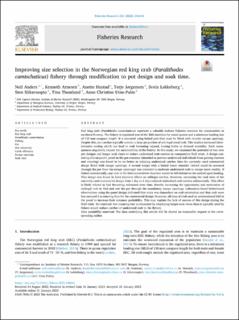| dc.contributor.author | Anders, Neil | |
| dc.contributor.author | Arnesen, Kenneth | |
| dc.contributor.author | Hustad, Anette | |
| dc.contributor.author | Jørgensen, Terje | |
| dc.contributor.author | Løkkeborg, Svein | |
| dc.contributor.author | Siikavuopio, Sten Ivar | |
| dc.contributor.author | Thesslund, Tina | |
| dc.contributor.author | Utne-Palm, Anne Christine | |
| dc.date.accessioned | 2023-04-28T11:21:35Z | |
| dc.date.available | 2023-04-28T11:21:35Z | |
| dc.date.created | 2023-02-28T13:25:19Z | |
| dc.date.issued | 2023 | |
| dc.identifier.citation | Fisheries Research. 2023, 261:106641 1-10. | |
| dc.identifier.issn | 0165-7836 | |
| dc.identifier.uri | https://hdl.handle.net/11250/3065529 | |
| dc.description.abstract | Red king crab (Paralithodes camtschaticus) represent a valuable inshore fisheries resource for communities in northern Norway. The fishery is regulated east of the 26th meridian by vessel quotas and a minimum landing size of 130 mm carapace length. It is executed using baited pots that must be fitted with circular escape openings. Despite this, pot catches typically contain a large proportion of sub-legal sized crab. This implies increased labor-intensive sorting which can lead to crab becoming injured, loosing limbs or delayed mortality. Such consequences negatively impact the sustainability of the fishery. In this study, we examined the potential of two new pot designs and longer soak times to reduce undersized crab catches in comparative field trials. A design consisting of a tarpaulin panel on the pot entrance (intended to prevent undersized individuals from gaining traction and entering) was found to be no better at reducing undersized catches than the currently used commercial design fitted with escape openings. A second design with a baited lower chamber (which could be accessed through the pot floor via escape openings) was intended to motivate undersized crab to escape more readily. If fished commercially, any crab in the bottomless lower chamber would be left behind on the seabed upon hauling. This design was found to have minimal effects on sublegal catches. However, increasing the soak time of the currently used commercial design from 1 day to 4 days reduced undersized crab catches substantially. This effect is likely related to bait becoming exhausted over time, thereby increasing the opportunity and motivation of sublegal crab to find and exit the pot through the mandatory escape openings. Laboratory-based behavioural observations using the panel design indicated that entry was dependent on crab orientation and that crab were less successful at entering than for the commercial design. However, all sizes of crab used an unintentional fold in the panel to increase their entrance probability. This may explain the lack of success of this design during the field trials. We conclude that ensuring bait is exhausted by employing longer soak times than is typically used by fishers would reduce catches of undersized crab in the fishery. | |
| dc.language.iso | eng | |
| dc.title | Improving size selection in the Norwegian red king crab (Paralithodes camtschaticus) fishery through modification to pot design and soak time. | |
| dc.title.alternative | Improving size selection in the Norwegian red king crab (Paralithodes camtschaticus) fishery through modification to pot design and soak time. | |
| dc.type | Peer reviewed | |
| dc.type | Journal article | |
| dc.description.version | publishedVersion | |
| dc.source.pagenumber | 1-10 | |
| dc.source.volume | 261:106641 | |
| dc.source.journal | Fisheries Research | |
| dc.identifier.doi | 10.1016/j.fishres.2023.106641 | |
| dc.identifier.cristin | 2130098 | |
| cristin.ispublished | true | |
| cristin.fulltext | original | |
| cristin.qualitycode | 1 | |
